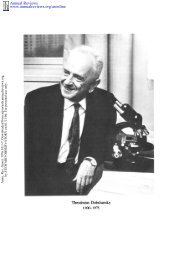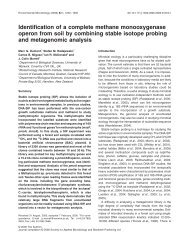Conservation of the vaquita Phocoena sinus - The Department of ...
Conservation of the vaquita Phocoena sinus - The Department of ...
Conservation of the vaquita Phocoena sinus - The Department of ...
You also want an ePaper? Increase the reach of your titles
YUMPU automatically turns print PDFs into web optimized ePapers that Google loves.
188 L. Rojas-Bracho, R. R. Reeves and A. Jaramillo-Legorreta<br />
for totoaba and while trawling for shrimp (Norris & Prescott, 1961). Many years later, Norris<br />
(1992) recalled that entanglement occurred ‘<strong>of</strong>ten’, and that both <strong>the</strong> shrimp trawl fishery<br />
and <strong>the</strong> large-mesh gillnet fishery for sharks and totoaba ‘kill[ed] <strong>the</strong>ir share <strong>of</strong> <strong>vaquita</strong>s’.<br />
Unfortunately, no record <strong>of</strong> any sort was kept or obtained by Mexican fishery authorities<br />
and scientists, so it is impossible to estimate <strong>the</strong> scale <strong>of</strong> catches in those days.<br />
From around <strong>the</strong> mid-1930s (Brownell, 1982) to <strong>the</strong> mid-1970s (Flanagan & Hendrickson,<br />
1976), <strong>the</strong> most important fishery in terms <strong>of</strong> <strong>vaquita</strong> by-catch was <strong>the</strong> commercial gillnet<br />
fishery for totoaba (closed in 1975, see below). Most authors who have considered <strong>the</strong> issue<br />
in detail have reached <strong>the</strong> same conclusion, starting with Norris & McFarland (1958) and<br />
continuing through more recent studies (e.g. Findley & Vidal, 1985; Robles, Vidal & Findley,<br />
1987; Vidal, Van Waerebeek & Findley, 1994; Vidal, 1995). Fleischer (1994, 1996) is <strong>the</strong> most<br />
noteworthy exception to this conventional opinion. Fleischer (1996) reported a <strong>vaquita</strong><br />
bycatch rate <strong>of</strong> 0.0058/set for 682 observed sets in an experimental totoaba gillnet fishery<br />
between 1983 and 1993, and that no <strong>vaquita</strong>s at all were caught in 632 sets ‘examined directly’<br />
in 1993 (315 and 317, respectively, in <strong>the</strong> two main fishing ports). His overall conclusion was<br />
that by-catch in fisheries was not necessarily a major threat to <strong>the</strong> <strong>vaquita</strong> (see below).<br />
Using Fleischer’s data on <strong>vaquita</strong> bycatch rate toge<strong>the</strong>r with his data on fishing effort and<br />
yield (Fleischer, 1994), T. Gerrodette (in Rojas-Bracho & Taylor, 1999) estimated <strong>the</strong> bycatch<br />
rate in <strong>the</strong> totoaba experimental fishery at 58 <strong>vaquita</strong>s/year – a significantly high number.<br />
However, a closer examination <strong>of</strong> <strong>the</strong> data now available on <strong>vaquita</strong> mortality in <strong>the</strong> experimental<br />
totoaba fishery leads us to conclude that 58 porpoises/year may be a negatively biased<br />
estimate. Vidal (1995; his appendix table 2) listed 77 <strong>vaquita</strong>s definitely known to have been<br />
bycaught in totoaba gill nets during <strong>the</strong> period <strong>of</strong> <strong>the</strong> experimental fishery, 1983–93 (Fig. 4).<br />
<strong>The</strong>se are only <strong>the</strong> animals for which reliable evidence could be obtained via sporadic and<br />
incomplete monitoring. It has proven impossible to determine how or why Fleischer (1994)<br />
reported only four <strong>vaquita</strong>s taken in <strong>the</strong> experimental fishery over <strong>the</strong> entire period from 1983<br />
to 1993; in contrast, Robles et al. (1987) reported 3.5 times that number (14) taken in <strong>the</strong><br />
same fishery in one area (near El Golfo de Santa Clara) during <strong>the</strong> months <strong>of</strong> March and<br />
May 1985 and February 1986. Seven <strong>of</strong> those 14 specimens were included in a sample <strong>of</strong> 13<br />
Fig. 4. Five <strong>vaquita</strong> calves awaiting necropsy at <strong>the</strong> ITESM-Guaymas laboratory. <strong>The</strong> calves were killed in<br />
gill nets set for totoaba, near El Golfo de Santa Clara, March–April 1991. Photo by Omar Vidal.<br />
© 2006 <strong>The</strong> Authors. Issue compilation © 2006 Mammal Society, Mammal Review, 36, 179–216




